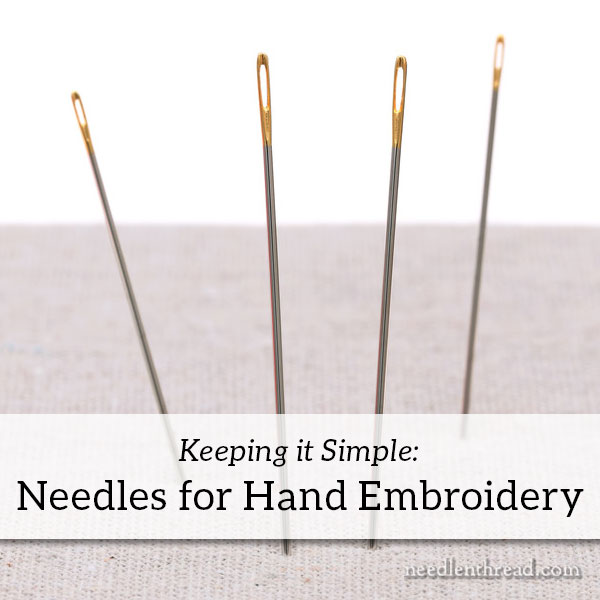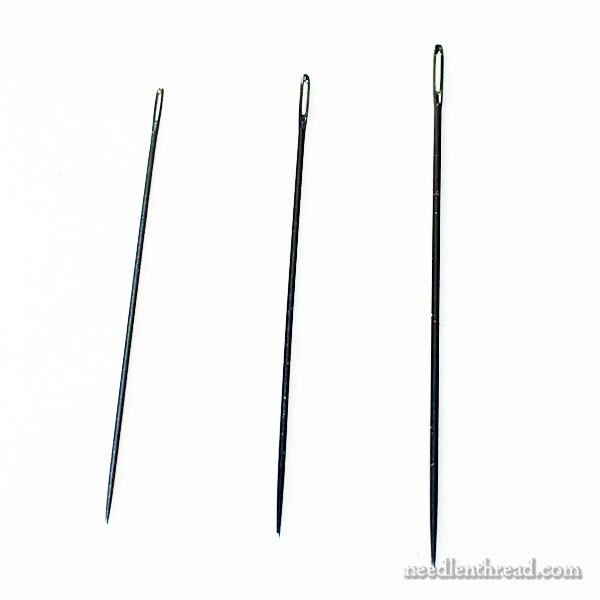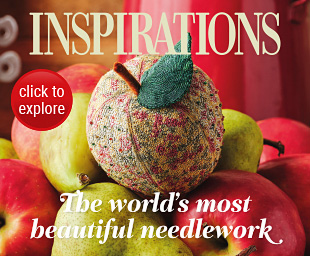I’ve written a lot about hand embroidery needles here on Needle ‘n Thread. After all, when it comes to embroidery, the needle plays a fairly prominent roll in the art. Without a needle, where would we be?
In past articles on the subject, I’ve covered lots of ground about all different types of needles. For those who want to know more about embroidery needles, you’ll find a nice list for further reading at the end of this article.
You’ll also find a link to a PDF you can download onto your computer for future reference on needles in general, thanks to the John James needle company.
But today’s article is all about simplicity. I get a lot of inquiries about what needles (type and size) to use for standard surface embroidery. For the sake of newbies and experienced embroiderers alike, I’m going to give a fairly simple answer to this question.
Think of this as a starting point (no pun intended…) or even an ending point.
I’ll explain…

It is true that there are many types of needles that come in various sizes to handle different tasks associated with hand embroidery – and specifically, associated with what I classify as surface embroidery as opposed to counted work.
And yes, I have a bunch of needles, and I often choose different types for different tasks.
But when it comes down to it, I find that three sizes of one type of needle will do me fine and take me through just about any embroidery task involving commonly used threads for common types of surface embroidery.

The type of needle is the crewel needle, which is also called an embroidery needle. Sometimes, you’ll see these needles labeled as “crewel” and sometimes, they’ll be labeled “embroidery.” They’re the same type of needle – a somewhat elongated eye with a sharp point.
The three sizes that I use most commonly are shown in the photo above (left to right): 10, 9, and 7. You can do just about any embroidery task with these three needles.
(Keep in mind, you’re seeing them enlarged in the photo above, just so you can see the size in relation to each other. The needles are not as large as they appear in the photo!)
What You Can Do with Them
With size 7, you can do crewel work with crewel wool. You can work easily with two-to-(sort of)-four strands of cotton floss (but three are more comfortable and more common). You can work with fine perle threads (8 and 12) and finer buttonhole silks. You can work with coton a broder and floche – although they also work well with a smaller needle.
With size 9, you can work with two strands of cotton or silk floss. You can work with cotton floche and most sizes of coton a broder, and with fine perle cottons (12). You can also work with one strand of floss, for needle painting or very fine lines, but the smaller #10 needle (mentioned below) makes very fine embroidery with one strand of floss a little more precise.
With size 10, you can work with one strand of floss or stranded silk. The smaller size 10 is especially suitable for needle painting with single strands of floss, for split stitch with single strands of floss, and for tiny stitches like little seed stitches, tiny French knots and the like, with single strands of floss.
You can use two strands of floss in a #10 needle, too, if you want the smaller needle for the stitch you’re working, but it’s harder to thread – so in that case, just double one thread in the needle by drawing the thread through the eye to its halfway point.
With crewel needles, you can work pretty much any embroidery stitch, including bullion knots and cast-on stitches and the like. Even though these types of stitches are easier to work with a milliner needle, they can still be accomplished with a crewel needle.
Starting Out?
Chances are, if you’re just starting out in embroidery, you really only need a variety pack of crewel (aka “embroidery”) needles. Variety packs will usually come in sizes 3-9 or 5-10. Get one of each, and you’ve got all your embroidery needs covered.
An Online Resource
For those who want a visual guide for needle types and sizes, the John James needle company has this very handy Needle Types and Sizes guide available. It’s a PDF, so you can save it to your computer for future use, or print it out and tuck it in your tool box.
More Reading
While you can definitely keep things simple with the suggestion of three sizes of crewel needles above – and still produce perfectly beautiful embroidery – it’s true that the right tool usually makes a job easier.
If you want to delve into embroidery needles for different tasks, to learn more about them and which ones are good for what, here’s a list of articles that touch on the subject of different needles for hand embroidery:
Embroidery Needles: How to Choose Them and Use Them
The Needle You Need – an overview of the Chenille Needle and what it can do for you
All About Embroidery Needles – Types, Storage, Organization, Resources
5 Things You Need to Know about Hand Embroidery Needles
Perfect French Knots, Perfect Bullions – the Milliner (or “straw”) Needle
Gold Embroidery Needles – Are They Better?
Pitching a Curve – on curved needles and why you need one
Coming Up on Needle ‘n Thread
There’s a delectable new book out that I’m going to review for you shortly. And I’ll show you a wee bit of progress on my silk gauze piece and chat a bit about the silk threads on that particular project and how I reorganized them.
I’m working behind the scenes on some Big Stuff, too, not least of which is the on-going quest to get my workroom situated. I’ll share the next step in that journey – soon as I take it, that is! It’s planned for today.
And the tooth – thanks for all the encouragement! Yep, made it to the dentist. It’s calming down now. I might be able to pull my head together and actually get something done today!







Dear Mary
I use mainly Bohin needles as I like the fineness of them, I normally use size 9 but that is a good tip to use 10 for needle painting which is my current project, I will try that. I like that you make it so simple using 3 needles for different embroidery. I really appreciate the PDF needle guide this will come in very handy for future projects. Thanks for sharing the links to all your links on needles and for sharing your tips and techniques on needles with us. I looking forward to the book review and the latest on your workroom. I’m so glad you made it to the dentist and you are feeling better, I got an appointment on Friday yuk.
Regards Anita Simmance
Sigh! I hope that your dentist appointment isn’t for anything too serious, Anita! Teeth – they’re pretty important. But gosh, can they ever hurt!
OMG thank you! I have been wondering about all the different types of needles for so long! This article, and the ones you linked to, are going to help me so much. I feel like I can actually make a decently organized needlebook now!
My favorite size is definitely 7. They are so versatile and easy to thread! Actually sometimes I use them for sewing too!
Looking forward to your piece on silk thread… I haven’t dared to used it yet, it looks so precious and fragile…
Mary,
I look forward to your daily emails. Embroidery is my favorite thing to do. Thanks for sharing tips on fabric, needles, threads and stitches. You really encourage me to try something new.
Hi Mary,
Glad to hear you had a successful dentist appointment, Your right teeth are important.
Thanks for the information on needles. It cleared up a lot. If I could get the thread through the eye, I used it. I like the idea of the packages with a verity of sizes, sure would make things simple. I’m looking forward to seeing you work room. Sound like you have quiet a project going on. Your plans for future post sound quite interesting also. Late last year you mention that you had taken lessons for tatting with a shuttle, how is it going for you? Good luck with your tatting.
Happy Stitching,
Louann P
Brilliant pdf from John James. Thanks for attaching it.
Right on Mary.
Don’t care if they are gold tipped or not. I buy them in bundles of 20 per size.
Depending on the pattern, I thread 5 to 10 up with particular colour. When I finish those 10 needles, I stop have a cup of tea or tidy up the room. If I am tired I stop sewing for that day. My little dog seems to know when I am nearly done and sits close. We might even go for a walk. That’s best of all for us both.
MM